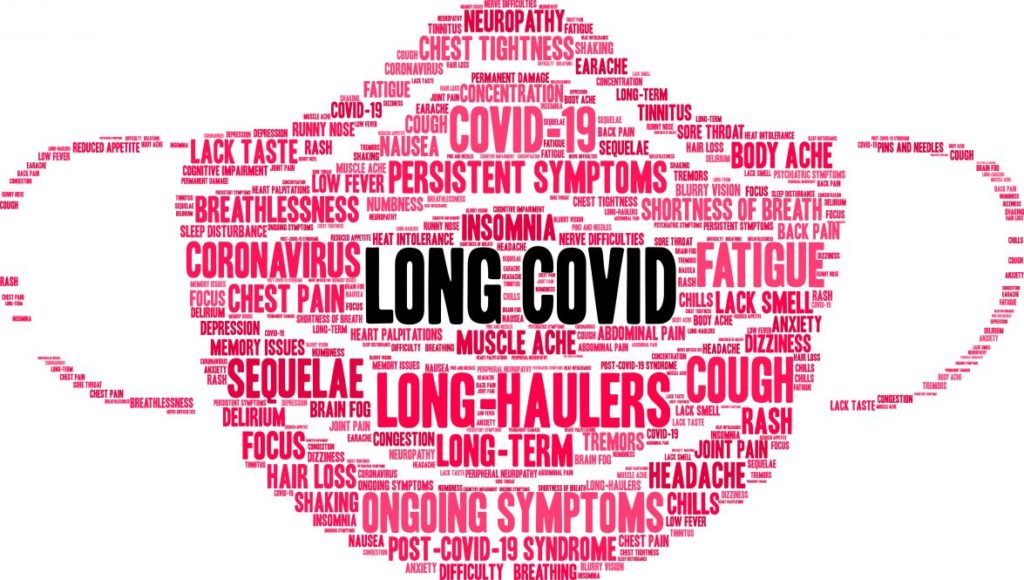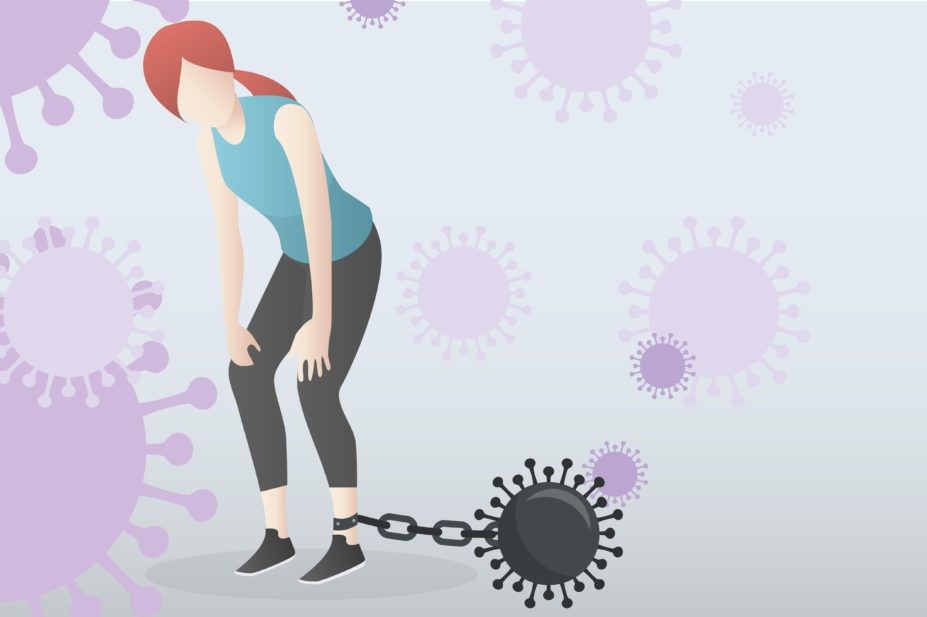Long COVID is becoming more of a prevalent issue in our community and, as such, we felt it was important that we have a better understanding about what it is and what we can do to help.
Isabella, one of our fantastic physiotherapists, has done some in-depth research to help us all better understand what long COVID is and what strategies we can use to help manage symptoms.

What is long COVID
Long COVID has been preliminarily defined as the presence of signs and symptoms that develop during or following an infection consistent with COVID-19 which continues for 12 weeks or more.
How common is long COVID?
1 in 10 of all cases will exhibit symptoms for a period of 12 weeks or longer.
Most common symptoms after 6 months
- Extreme exhaustion (fatigue)
- Post-exertional symptom exacerbation (PESE)
- Problems with memory and concentration (brain fog)
Other common symptoms
- Shortness of breath
- Chest pains or tightness
- Difficulty sleeping (insomnia)
- Heart palpitations
- Dizziness
- Muscle pain
- Joint pain
- Depression and anxiety
- Tinnitus, earaches
- Feeling sick, diarrhoea, stomach aches, loss of appetite
- A high temperature, cough, headaches, sore throat, changes to sense of smell or taste
- Rashes

Rehabilitation and long COVID
What is rehabilitation?
Rehabilitation is defined as a set of interventions to optimise functioning in everyday activities, to support individuals to recover or adjust and achieve their full potential, and to enable participation in education, work, recreation, and meaningful life roles (World Health Organisation, 2021)
According to the World Health Organization (WHO), rehabilitation for Long COVID patients should include teaching them how to resume daily activities at a pace that is safe and manageable for their energy levels, within the parameters of their current symptoms, and without pushing themselves to the point of exhaustion or worsening their symptoms.
Rehabilitation that is safe and effective is a crucial component of recovery. Long COVID rehabilitation must be personalised for each individual depending on their symptoms, goals, and preferences.
Fatigue and post-exertional symptoms exacerbation
Fatigue
The most common symptom of Long COVID is fatigue, which is a feeling of extreme exhaustion. It can make it difficult to perform day-to-day tasks and is not easily relieved by rest or sleep.
PESE
Post-exertional symptom exacerbation (PESE) is a disabling and often delayed exhaustion disproportionate to the effort made. Some people refer to it as a “crash.” Activities that were previously managed effortlessly may now cause symptoms to intensify, for example:
- A daily activity (e.g. having a shower)
- A social activity
- Walking
- Reading, writing, or working at a desk
- Being in a sensory environment (e.g. loud music or flashing lights)
Exercise and physical activity are the main causes of PESE. Nearly 75% of people living with long COVID still experience PESE after 6 months.

How to use pacing with your physiotherapist
(sourced from Physiotherapy New Zealand)
Pacing is a self-management technique used during activity to prevent the exacerbation of post-exertional symptoms exacerbation (PESE). Pacing is keeping activities brief, taking frequent breaks, and doing less than you have energy for.
Use the 4 P’s to help you plan your activities
- Prioritise what you really need to do in a day or week. Consider whether some tasks are truly necessary. Can anybody else do it? Can I modify the task, so that it is easier for me?
- Plan in your main prioritised tasks for the day. Plan ahead for rest time so the day is well-paced.
- Pacing – your activity should be divided into smaller, easier-to-manage tasks with rest periods.
- Pleasure – spend some energy on things you enjoy to help improve your quality of life
Fatigue
- Be kind to yourself. Don’t overload or take on too much. Remember to ask for help when needed.
- Prioritising your time and activities to keep within your available energy levels can help you stay within them. You can do this by determining which chores require more or less energy. It can be helpful to understand which activities make you feel more or less worn out by keeping a record of how you feel after each activity.
- Pace yourself by dividing up activities into smaller ones or splitting up larger ones, and give yourself time to recover in between. Pick some enjoyable things to engage in to support your mental wellbeing.
- Take regular breaks throughout the day, and if you feel like you need a rest, pay attention to your body.
- Try to avoid forcing yourself to continue when you are exhausted. Exercise is not recommended for rehabilitation of people experiencing PESE as it can worsen symptoms.
- Modify activities to make them easier on yourself, e.g. sitting down to prepare the vegetables for dinner.
- Getting outside and spending time in nature can have benefits for both your mental and physical health.
Muscle and Joint Pain
- Some patients with Long COVID experience muscle aches and joint pain. Gentle stretching and yoga may help relieve these symptoms.
- Check with your physiotherapist or health professional before starting any exercises.
Return to Exercise
- Exercise is not recommended if it worsens your fatigue.
- If you are not experiencing worsening symptoms, starting an exercise programme slowly and cautiously is recommended. You should keep a close eye on how you respond to physical activity. A physiotherapist can support you through a safe return to exercise.
References
Davis, H., Assaf, G., McCorkell, L., Wei, H., Low, R., & Re’em, Y. et al. (2020). Characterizing long COVID in an international cohort: 7 months of symptoms and their impact. Eclinicalmedicine, 38. DOI: 10.1016/j.eclinm.2021.101019
Media Statement: Managing Long COVID in Aotearoa : PNZ. (2022). Retrieved 4 July 2022, from https://pnz.org.nz/Story?Action=View&Story_id=4948
National Institute for Health and Care Excellence (NICE), Scottish Intercollegiate Guidelines Network (SIGN) and Royal College of General Practitioners (RCGP). (2022). COVID-19 rapid guideline: managing the longterm effects of COVID-19 [Ebook]. Retrieved from https://www.nice.org.uk/guidance/ng188/chapter/Recommendations
Long COVID. (2022). Retrieved 4 July 2022, from https://www.health.govt.nz/covid-19-novel-coronavirus/covid-19-health-advice-public/about-covid-19/long-covid#understand
Rehabilitation. (2022). Retrieved 4 July 2022, from https://www.who.int/news-room/fact-sheets/detail/rehabilitation
World PT Day 2021: information sheets (English). (2022). Retrieved 13 July 2022, from https://world.physio/toolkit/world-pt-day-2021-information-sheets-english
